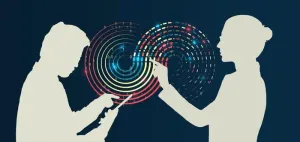(Press-News.org) The potential of human-AI collaboration has captured our imagination: a future where human creativity and AI's analytical power combine to make critical decisions and solve complex problems. But new research from the MIT Center for Collective Intelligence (CCI) suggests this vision may be much more nuanced than we once thought.
Published today in Nature Human Behaviour, “When Combinations of Humans and AI Are Useful” is the first large-scale meta-analysis conducted to better understand when human-AI combinations are useful in task completion, and when they are not. Surprisingly, the research has found that combining humans and AI to complete decision-making tasks often fell short; but human-AI teams showed much potential working in combination to perform creative tasks.
The research, conducted by MIT doctoral student and CCI affiliate Michelle Vaccaro, and MIT Sloan School of Management professors Abdullah Almaatouq and Thomas Malone, arrives at a time marked by both excitement and uncertainty about AI’s impact on the workforce. Instead of focusing on job displacement predictions, Malone said that he and the team wanted to explore questions they believe deserve more attention: When do humans and AI work together most effectively? And how can organizations create guidelines and guardrails to ensure these partnerships succeed?
The researchers conducted a meta-analysis of 370 results on AI and human combinations in a variety of tasks from 106 different experiments published in relevant academic journals and conference proceedings between January 2020 and June 2023. All the studies compared three different ways of performing tasks: a.) human-only systems b.) AI-only systems, and c.) human-AI collaborations. The overall goal of the meta-analysis was to understand the underlying trends revealed by the combination of the studies.
Test Outcomes
The researchers found that on average, human-AI teams performed better than humans working alone, but didn't surpass the capabilities of AI systems operating on their own.
Importantly, they did not find “human-AI synergy,” which means that the average human-AI systems performed worse than the best of humans alone or AI alone on the performance metrics studied. This suggests that using either humans alone or AI systems alone would have been more effective than the human-AI collaborations studied.
“There’s a prevailing assumption that integrating AI into a process will always help performance — but we show that that isn’t true,” said Vaccaro. “In some cases, it’s beneficial to leave some tasks solely for humans, and some tasks solely for AI.”
The team also identified factors affecting how well humans and AI work together. For instance, for decision-making tasks like classifying deep fakes, forecasting demand, and diagnosing medical cases, human-AI teams often underperformed against AI alone.
However, for many creative tasks, such as summarizing social media posts, answering questions in a chat, or generating new content and imagery, these collaborations were often better than the best of humans or AI working independently.
“Even though AI in recent years has mostly been used to support decision-making by analyzing large amounts of data, some of the most promising opportunities for human-AI combinations now are in supporting the creation of new content, such as text, images, music, and video,” said Malone.
The team theorized that this advantage in creative endeavors stems from their dual nature: While these tasks require human talents like creativity, knowledge, and insight, they also involve repetitive work where AI excels. Designing an image, for instance, requires both artistic inspiration — where humans excel — and detailed execution — where AI often shines. In a similar vein, writing and generating many kinds of text documents requires human knowledge and insight, but also involves routine, and automated processes such as filling in boilerplate text.
“There is a lot of potential in combining humans and AI, but we need to think more critically about it,” said Vaccaro. “The effectiveness is not necessarily about the baseline performance of either of them, but about how they work together and complement each other.”
Optimizing collaboration
The research team believes its findings provide guidance and lessons for organizations looking to bring AI into their workplaces more effectively. For starters, Vaccaro emphasized the importance of assessing whether humans and AI are truly outperforming either humans or AI working independently.
“Many organizations may be overestimating the effectiveness of their current systems,” she added. “They need to get a pulse on how well they’re working.
Next, they need to evaluate where AI can help workers. The study indicates that AI can be particularly helpful in creative tasks, so organizations should explore what kinds of creative work could be ripe for the insertion of AI.
Finally, organizations need to set clear guidelines and establish robust guardrails for AI usage. They might, for example, devise processes that leverage complementary strengths. “Let AI handle the background research, pattern recognition, predictions, and data analysis, while harnessing human skills to spot nuances and apply contextual understanding,” Malone suggested. In other words: “Let humans do what they do best.”
Malone concluded: “As we continue to explore the potential of these collaborations, it's clear that the future lies not just in replacing humans with AI, but also in finding innovative ways for them to work together effectively.”
END
Humans and AI: Do they work better together or alone?
New MIT Sloan research has found human-AI combinations often perform worse in decision-making tasks than the best of humans or AI alone. But the partnerships showed much promise in creative tasks.
2024-10-28
ELSE PRESS RELEASES FROM THIS DATE:
Childhood attention issues and genetic factors may predict psychosis risk
2024-10-28
Researchers at UCLA Health have found that a person's risk of developing psychotic-like experiences may be influenced by both childhood attention problems and their genetic makeup.
The findings, published in Nature Mental Health, build upon a long-studied association between childhood attention problems and the likelihood of later developing schizophrenia. Using data from about 10,000 children over six years, UCLA researchers led by Dr. Carrie Bearden sought to determine how attentional variability ...
Amsterdam UMC study proves impact of rapid first shock after cardiac arrest
2024-10-28
It is well known that acting quickly in the event of a cardiac arrest is important, but what does a quick initial shock with a defibrillator mean exactly for patients' chances of survival? Researchers from Amsterdam UMC analysed the data of 3723 patients who had a cardiac arrest outside the hospital and concluded that for the first shock, every minute reduces the chance of survival by 6%. The results of this research were published today in the international journal Circulation.
"Our research shows that every minute of delay in giving the first shock has a major impact. If the first shock was given within six minutes, it was possible ...
Children’s BMI can affect their future lung function
2024-10-28
An abnormal BMI in children – be it high or low – can now be associated with impaired lung function, but if their BMI is normalised before they reach adulthood, the impairment can be offset, researchers from Karolinska Institutet report. Their results, which are based on data collected under the BAMSE project in Sweden, are presented in The European Respiratory Journal.
One in ten people have reduced lung function development in childhood and cannot achieve maximal lung capacity in adulthood, increasing the risk of serious health problems such as cardiovascular disease, lung disease and diabetes. One risk factor associated with impaired lung function development is abnormal ...
Don't worry. Study shows you're likely a more creative writer than ChatGPT. For now
2024-10-28
Imagine you decide to write a short story about a protagonist who creates an artificial human and then falls in love with it. What gender is your protagonist? What about the artificial human? Would you write a moving love story? A cautionary dystopian tale?
Would your story be more compelling than one written by ChatGPT?
Likely yes, says Nina Beguš, a researcher and lecturer in UC Berkeley's School of Information and Department of History. Leveraging her background in comparative literature ...
Heart failure mortality declining in Sweden
2024-10-28
A new study from Karolinska Institutet shows that heart failure mortality has decreased in Sweden over the last 20 years. The study has been published in the European Journal of Heart Failure.
A national study has shown that heart failure mortality has decreased in Sweden over the last two decades. Despite these improvements, the prognosis for heart failure patients remains worrying – 25 percent of those diagnosed in 2022 died within a year.
“Our results suggest that advances in heart failure treatment over the past decades have reduced heart failure mortality, both at the population level and for individual patients. ...
Understanding how mutations affect diseases
2024-10-28
Many statistical models and algorithms used by scientists can be imagined as a “black box.” These models are powerful tools that give accurate predictions, but their internal workings are not easily interpretable or understood. In an era dominated by deep learning, where an ever-increasing amount of data can be processed, Natália Ružičková, a physicist and PhD student at the Institute of Science and Technology Austria (ISTA), chose to take a step back. At least in the context of genomic ...
Quality control in artificial photosynthesis: validating natural antenna mimicry
2024-10-28
Humans can do plenty, but plants have an ability we don’t: they make energy straight from sunlight, a superpower called photosynthesis. Yet new research shows that scientists are closing that gap.
Osaka Metropolitan University researchers have revealed the 3D structure of an artificial photosynthetic antenna protein complex, known as light-harvesting complex II (LHCII), and demonstrated that the artificial LHCII closely mirrors its natural counterpart. This discovery marks a significant step forward in understanding how plants harvest and manage solar energy, paving the way for future innovations in artificial ...
When science speaks in extremes
2024-10-28
“Vaccines are 100% safe, and anyone who doubts this is ignorant”: Have you ever come across messages like this during the pandemic crisis a few years ago? If you often feel that certain public debates—such as those on vaccines or the climate crisis—boil down to a black-and-white clash between two sides demanding, with harsh tones, unquestioning allegiance to their view, you're not entirely wrong. We are rightly accustomed to being warned about pseudoscientific misinformation and fake news, and much research has been devoted ...
Will the ocean suffer an epidemic?
2024-10-28
Written by a team of European experts from the marine sciences, Navigating the Future VI discusses how the biodiversity crisis is being played out in the Ocean. It notes that Ocean species large and small are far less well described than their terrestrial counterparts, making it harder to measure declines and their impacts. This publication provides governments, policymakers and funders with robust, independent scientific advice on future seas and Ocean research. With the COP16 on biodiversity already in full swing in Cali, Colombia, it is timely to reflect further on the need to better understand our Ocean biodiversity.
“Climate change ...
A single thin film perfectly absorbs all electromagnetic waves!
2024-10-28
The research team of Dr. Byeongjin Park and Dr. Sang Bok Lee from the Composites & Convergence Materials Research Division at the Korea Institute of Materials Science (KIMS), has developed the world's first ultra-thin film composite material capable of absorbing over 99% of electromagnetic waves from various frequency bands (such as 5G/6G, WiFi, and autonomous driving radar) using a single material.
This electromagnetic wave absorption and shielding material is less than 0.5mm thick and is distinguished by its low reflectance ...
LAST 30 PRESS RELEASES:
UVA’s Jundong Li wins ICDM’S 2025 Tao Li Award for data mining, machine learning
UVA’s low-power, high-performance computer power player Mircea Stan earns National Academy of Inventors fellowship
Not playing by the rules: USU researcher explores filamentous algae dynamics in rivers
Do our body clocks influence our risk of dementia?
Anthropologists offer new evidence of bipedalism in long-debated fossil discovery
Safer receipt paper from wood
Dosage-sensitive genes suggest no whole-genome duplications in ancestral angiosperm
First ancient human herpesvirus genomes document their deep history with humans
Why Some Bacteria Survive Antibiotics and How to Stop Them - New study reveals that bacteria can survive antibiotic treatment through two fundamentally different “shutdown modes”
UCLA study links scar healing to dangerous placenta condition
CHANGE-seq-BE finds off-target changes in the genome from base editors
The Journal of Nuclear Medicine Ahead-of-Print Tip Sheet: January 2, 2026
Delayed or absent first dose of measles, mumps, and rubella vaccination
Trends in US preterm birth rates by household income and race and ethnicity
Study identifies potential biomarker linked to progression and brain inflammation in multiple sclerosis
Many mothers in Norway do not show up for postnatal check-ups
Researchers want to find out why quick clay is so unstable
Superradiant spins show teamwork at the quantum scale
Cleveland Clinic Research links tumor bacteria to immunotherapy resistance in head and neck cancer
First Editorial of 2026: Resisting AI slop
Joint ground- and space-based observations reveal Saturn-mass rogue planet
Inheritable genetic variant offers protection against blood cancer risk and progression
Pigs settled Pacific islands alongside early human voyagers
A Coral reef’s daily pulse reshapes microbes in surrounding waters
EAST Tokamak experiments exceed plasma density limit, offering new approach to fusion ignition
Groundbreaking discovery reveals Africa’s oldest cremation pyre and complex ritual practices
First breathing ‘lung-on-chip’ developed using genetically identical cells
How people moved pigs across the Pacific
Interaction of climate change and human activity and its impact on plant diversity in Qinghai-Tibet plateau
From addressing uncertainty to national strategy: an interpretation of Professor Lim Siong Guan’s views
[Press-News.org] Humans and AI: Do they work better together or alone?New MIT Sloan research has found human-AI combinations often perform worse in decision-making tasks than the best of humans or AI alone. But the partnerships showed much promise in creative tasks.






